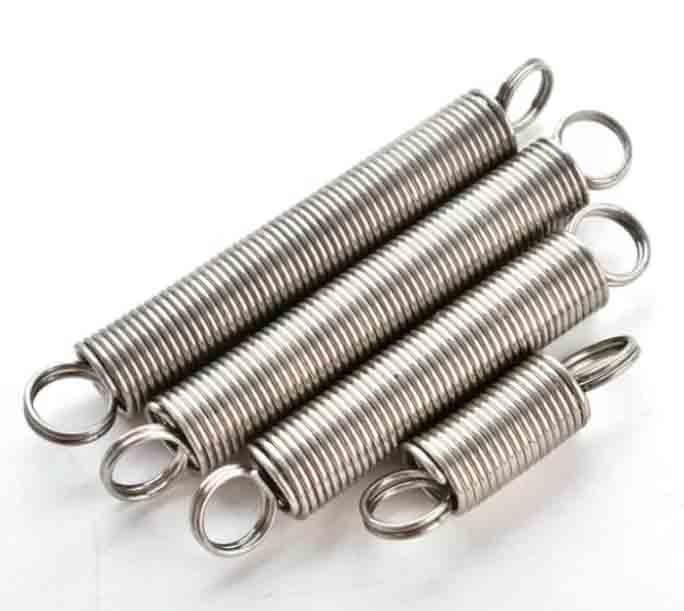Basic Knowledge For Various Types Of Springs

Spring is everywhere in various machines. From consumer goods to heavy industrial equipment, as long as you remove anything involving mechanical devices, you may find the spring inside, which is a mechanical storage device.

Cylindrical Helical Spring
Circular cross-section type
It is a compression spring with a circular section.
The characteristic line is linear, stable in stiffness, with a simple structure, convenient manufacturing, and wide application. It is mostly used as a buffer, vibration reduction, energy storage, and control movement in mechanical equipment.
Rectangular cross-section type
Under the same space conditions, the cylindrical spiral compression spring with a rectangular cross-section has greater rigidity and more absorption energy than the circular section type. The characteristic line is closer to the straight line and the stiffness is closer to the constant.
Flat-shaped section type
Compared with the circular cross-section type, the cylindrical helical spring with a flat-shaped section has large storage energy and large compression. Therefore, it is widely used in the installation space such as engine valve mechanisms, clutch, and automatic transmission.
Variable pitch type
When the load is increased to a certain degree, as the load increases, the spring gradually tightens the spacing from the section, and the stiffness gradually increases. Therefore, its autobiography frequency becomes a variable value, which has a good effect on eliminating or easing resonance and is widely used for high-speed load-changing mechanisms.
Multi-wire type
The material is steel wire rope. When it is not loaded, the contact between the steel wires is relatively loose. When the external load reaches a certain degree, the contact is tight and the spring rigidity has been increased. It is widely used in weapons and aero motors.
Extension Spring
The performance and characteristics of extension springs, are the same as the cylindrical helical spring with a circular cross-section. It is mainly used in situations under tensile load.
Torsion Spring
The torsion spring is under the torsion load, mainly used for compression, energy storage, and the elasticity of the transmission system. It has a linear characteristic line and wide applications, such as measuring metering and the compulsory air valve closure mechanism.
Conical Coil Spring
The role is similar to the variable pitch cylindrical helical spring. After the loading reaches a certain degree, the spring is gradually tightened from the large coil to the small coil. The stiffness increases gradually and the natural frequency is variable. It is conducive to eliminating or easing resonance and the anti-resonance capacity is strong. This spring structure is compact and stable. It is mostly used to withstand large loads and vibration reduction. For example, suspension springs are applied in heavy vibrating screens and automobile transmissions.
Spiral Spring
Compared with other springs, the spiral spring can absorb larger energy in the same space, and the friction between the plates can be used to attenuate vibration. It is often used to absorb thermal expansion deformation. The disadvantage is that the gap between the board is small and difficult to quench and the spray treatment cannot be performed. In addition, the manufacturing accuracy is not high enough. It can be used as a measuring element and pressing element.
Torsion Bar Spring
The torsion bar spring has a simple structure, but the requirements for the quality of materials and manufacturing accuracy are high. It is mainly used as a suspension spring for cars and small vehicles.
Ring-shaped Spring
The ring spring is widely used in occasions that need to absorb large energy but is limited by space, such as springs for locomotive traction devices, and buffer springs for cranes and cannons.
Leaf Spring
A leaf spring is a metal piece that has a rectangular cross-section, which is mainly used for situations when the loading and deformation are not large. It can be used as a sensitive element in the detection instrument or automatic device.
Plate Spring
The plate spring is laminated of multiple spring steel plates. It is widely used as a suspension device in cars, tractors, and trains, as a role of buffer and vibration reduction.
Rubber Spring
Due to the small elastic modulus of rubber springs, it can get greater elastic deformation, and it is easy to achieve the required non-linear characteristics. The shape is not restricted and the rigidity of each direction can be freely selected according to the design requirements. The rubber spring can withstand multi-directional loads at the same time, so it can simplify the structure of the system. The application of rubber springs on machinery equipment is increasing.
Rubber-metal Spring
The characteristic line is gradually increased. This rubber-metal helical spring has a larger rigidity compared to the rubber spring and has larger damping compared to metal springs. Therefore, it has the advantages of large loading capacity, strong vibration reduction, and wear resistance, suitable for suspension structures for mining machinery and heavy vehicles.
Air Spring
Air spring is a non-metallic spring that uses the compression of air to achieve elastic effects. It is widely used in vehicle suspension device, which can greatly improve the power performance of cars, so air spring is widely used on cars and trains.
- Art
- Causes
- Crafts
- Dance
- Drinks
- Film
- Fitness
- Food
- Games
- Gardening
- Health
- Home
- Literature
- Music
- Networking
- Other
- Party
- Religion
- Shopping
- Sports
- Theater
- Wellness
- IT, Cloud, Software and Technology


